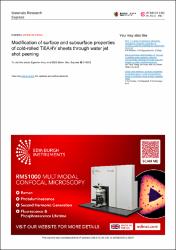| dc.contributor.author | Avcu, Egemen | |
| dc.contributor.author | Armagan, Mustafa | |
| dc.contributor.author | Yıldıran Avcu, Yasemin | |
| dc.contributor.author | Abakay, Eray | |
| dc.contributor.author | Çalım, Emirhan | |
| dc.contributor.author | Koç, Funda Gül | |
| dc.contributor.author | Güney, Mert | |
| dc.contributor.author | Yamanoğlu, Rıdvan | |
| dc.date.accessioned | 2025-03-18T08:14:05Z | |
| dc.date.available | 2025-03-18T08:14:05Z | |
| dc.date.issued | 2025 | en_US |
| dc.identifier.citation | Avcu, E., Armağan, M., Avcu, Y. Y., Abakay, E., Çalım, E., Koç, F. G., ... & Yamanoğlu, R. (2025). Modification of surface and subsurface properties of cold-rolled Ti6Al4V sheets through water jet shot peening. Materials Research Express, 12(1), 016503. | en_US |
| dc.identifier.issn | 2053-1591 | |
| dc.identifier.uri | https://hdl.handle.net/20.500.12960/1721 | |
| dc.description.abstract | Titanium alloys possess remarkable properties, such as high strength, biocompatibility, and resistance to corrosion. Nonetheless, both their surface and subsurface properties require improvements, particularly for applications where surface contact is unavoidable. The present study utilises an emerging mechanical surface treatment technique (water jet shot peening) for modifying the surface and subsurface characteristics of cold-rolled Ti6Al4V sheets. Water jet shot peening was applied on Ti6Al4V samples following an L18 full factorial experimental design, focusing on the variable parameters of process time, standoff distance, and shot mass flow rate. ANOVA indicated that the shot mass flow rate had the greatest impact on the roughness parameters (p < 0.0001). The roughness values of Ra, Rp, and Rv decreased as the shot's mass flow rate increased, and this decrease was more pronounced as the standoff distance diminished. The surface morphologies of the samples were notably modified by plastic deformation resulting from the repeated impact of shots. The water jet shot peening method modified the grains within the microstructure near the surface region. The grains in the microstructure were oriented perpendicularly to the peening direction to a depth of 5.36 mu m beneath the surface, even at minimal peening levels. The surface hardness increased by approximately 64% relative to the hardness of untreated Ti6Al4V alloy (512.43 Hv versus 311.52 Hv), attributed to significant plastic deformation and strain hardening induced by the high kinetic energy of the impacting shots during water jet peening. | en_US |
| dc.language.iso | eng | en_US |
| dc.publisher | IOP Publishing Ltd. | en_US |
| dc.relation.ispartof | Materials Research Express | en_US |
| dc.relation.isversionof | 10.1088/2053-1591/ada520 | en_US |
| dc.rights | info:eu-repo/semantics/openAccess | en_US |
| dc.subject | Strain hardening | en_US |
| dc.subject | Deformation | en_US |
| dc.subject | ANOVA | en_US |
| dc.subject | Titanium alloys | en_US |
| dc.subject | Tribological behaviour | en_US |
| dc.subject | Surface modification | en_US |
| dc.title | Modification of surface and subsurface properties of cold-rolled Ti6Al4V sheets through water jet shot peening | en_US |
| dc.type | article | en_US |
| dc.authorid | 0000-0003-0863-1651 | en_US |
| dc.department | Mühendislik Fakültesi, Makine Mühendisliği Bölümü | en_US |
| dc.contributor.institutionauthor | Çalım, Emirhan | |
| dc.identifier.volume | 12 | en_US |
| dc.identifier.issue | 1 | en_US |
| dc.identifier.startpage | 1 | en_US |
| dc.identifier.endpage | 16 | en_US |
| dc.relation.publicationcategory | Makale - Uluslararası Hakemli Dergi - Kurum Öğretim Elemanı | en_US |

















